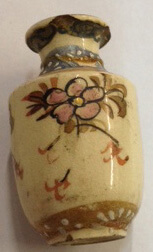
Many of you will know the Abbey Museum collection has quite an interesting history. A story that starts in England in the late 1800’s when a young English boy started to collect Roman coins and pottery taking them to the esteemed British Museum for identification. This young lad was John Sebastian Marlow Ward, a boy with a passion for history and understanding people of the past. In 1934 his collection had grown and he opened the Abbey Folk Park, the first social history museum in England. Ward amassed some 90,000 objects that covered the story of humankind over 500,000 years of world history.
Sadly the Second World War brought the closure of Ward’s Folk Park and in 1946 Ward and a small community he had formed, left England with only a small percentage of the original collection. One of the artefacts to set sail from England with Ward was a beautiful miniature Satsuma vase. Like many of his collection, it travelled to Cyprus where it languished for 9 years, before it was taken first to Sri Lanka (at that time Ceylon) via Egypt during the Suez Crisis of 1956. The sojourn in Sri Lanka was short lived and it wasn’t long before the little Satsuma vase and the other artefacts in Ward’s collection were reloaded on a ship heading for Australia.

You might be forgiven for wondering if the journey of the little Satsuma vase would ever end… well not yet. So from Fremantle it travelled to Sydney, and from Sydney to Blackheath in the Blue Mountains for a short but pleasant stay before travelling once again, this time by road up to Queensland.
Now the story gets interesting, because it was in the 1980’s that efforts were made to raise the $1,000,000 needed to build a gallery to house and display what remained of Ward’s collection. Opened in 1986 the Abbey Museum was recognised for the extent of its amazing collection of international fine arts and antiquities. I am sure many readers are familiar with the Museum’s displays – a time passage through the history of humankind in Europe followed by displays from the Classical and ancient worlds. And just when you think you have seen it all, you come to the last display in the Abbey Museum, a display on the history of Japan and their mighty samurai warriors. You might be mistaken to think that there in the Japanese case the exquisite miniature Satsuma vase might have pride of place. But alas no, for when the artefacts were being chosen for display, our little vase was nowhere to be found. It seems that at sometime on the long and often arduous journey from England the vase had gone missing. Nevertheless the Japanese display contains many beautiful objects, from a lovely lacquered writing box to a famous sword by the master Hichibejo Sukesada.
Lost Satsuma Vase found in Writing Box
Fast forward 29 years and it was on a sunny January Saturday that our Senior Curator removed the artefacts from the Japanese case as part of the program of photographing all the artefacts in the collection. Before returning them to the display our wonderful volunteer conservator was asked to give them a careful examination… her report read: “Would suggest it is not a good idea to store the little vase inside the writing box…” Little vase?? Writing box?? We were all aghast.. what little vase? And where in the writing box…but sure enough there in a little enclosed section at the back of the writing box snuggled our little lost Satsuma vase. Only four centimetres high and decorated with peach blossom, this vase would once have held a single bloom, maybe, just maybe on that table of the scribe who once used the writing box in which it was found.

